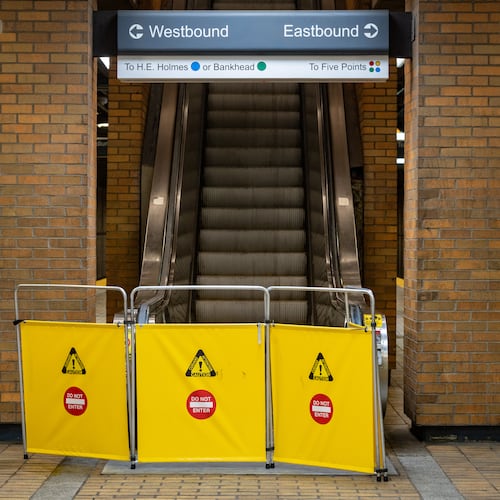At Medlock Bridge Park, a 12-acre greenspace tucked along the Chattahoochee and just inside the confines of Gwinnett County, a few dozen fledgling trees line a chain-link fence. Over by the playground and the pavilion, clusters of pollinator-friendly bushes are sprouting up.
Like thousands of other trees and shrubs recently planted across Gwinnett County’s park system, they’ll ultimately produce fruit and nuts for the public to pick, eat and share.
And they were purchased with COVID-19 relief funds.
Over two-plus years of pandemic, local governments in Georgia have poured tens of millions of federal relief dollars into things like vaccination and testing efforts, food giveaways and rental assistance initiatives.
Other expenditures — from the fruit trees in Gwinnett to garbage cans in Gainesville — have had more tenuous ties to the pandemic fight, raising questions about the political rationale used to push through unprecedented spending programs in the name of beating back the virus and returning to some version of normal.
“The further away from the immediate crisis and uncertainty, the more it seems this money has just kind of gone to whatever the officials in the jurisdictions wanted to do anyway,” said Kyle Wingfield, president and CEO of the Georgia Public Policy Foundation, which advocates for limited government and fiscal conservatism.
“This was done in the name of a pandemic and it’s turned into a lot more than that.”
That may be true. And by design.
While early pandemic programs like the CARES Act were aimed directly at addressing unexpected costs arising from the virus, the newer, $1.9-trillion American Rescue Plan has fewer strings and is intentionally targeted at promoting longer-term stability and infrastructure investments.
“The goal is to help governments recover and be resilient in that recovery, to provide services and make investments as they go forward,” said Usha Rackliffe, an associate professor of accounting at Emory University’s Goizueta Business School. “That’s the stated goal of this program.”
It’s complicated. But tight guidelines or lax, Georgia’s local governments have already used both programs to make purchases capable of furrowing a few brows.
And there are still millions more to be spent.
Credit: Jason Getz / Jason.Getz@ajc.com
Credit: Jason Getz / Jason.Getz@ajc.com
Creative CARES spending
In order to get a better picture of how Georgia governments are spending money from taxpayer-funded federal relief programs like American Rescue Plan and the earlier CARES Act, The Atlanta Journal-Constitution filed open records requests with the city’s five major metro governments, examined existing government databases and scoured news sources from across the state.
The investigation found that, to this point, Georgia’s local governments have in fact spent a large majority of their funds on directly combating the pandemic and its ramifications.
That analysis included money received from the CARES Act, which then-President Donald Trump signed into law in 2020. The legislation provided $150 billion to governments across the country, with guidance mandating money be spent on “necessary expenditures incurred due to the public health emergency” and items that weren’t already budgeted for.
In addition to sending money to local nonprofits, spending for personal protective equipment and other health-related projects, most if not all Georgia jurisdictions used significant chunks of their CARES money to cover salaries, bonuses or extra pay for frontline workers and law enforcement. The spending on public safety was explicitly allowed in the legislation and was justified by rising crime rates and first responders’ increased risk for exposure. In many cases, the spending on police accelerated as the deadline neared.
A few jurisdictions did find their way into hot water.
The Cobb County school district had to back off a plan to spend up to $12 million on ultraviolet sanitizing lights after one set malfunctioned at a local elementary school. And in the DeKalb County city of Stonecrest, now-former Mayor Jason Lary is awaiting sentencing on federal charges tied to a scheme in which he allegedly funneled $650,000 of CARES money to himself.
Others found creative, but seemingly permissible, ways to spend portions of their relief funding.
One tiny city outside Athens was reimbursed $45 for a Sam’s Club membership, which officials said would help them buy “COVID-19 materials” in bulk.
In Habersham County, Cornelia spent $141.25 on Everclear grain alcohol and lotion. The city clerk said those items were used for homemade hand sanitizer during early-pandemic shortages.
Gainesville went just a tad bigger.
The Hall County seat spent more than $340,000 on 7,000 roll carts for residents to use for household garbage.
The roll carts, officials wrote in state documents, would make it easier for residents to take their trash to the curb and limit how frequently sanitation workers had to enter someone’s garage or backyard to retrieve it, thereby improving social distancing efforts and limiting folks’ potential for exposure.
Gainesville city manager Bryan Lackey defended the expense — and said it had been “somewhat successful” in encouraging residents to bring trash to the curb, which is optional. But he told the AJC that he understands why it could raise some eyebrows.
Gwinnett County, meanwhile, sent CARES money to nonprofits and libraries. It spent about $1.6 million on retrofitting and otherwise supporting pandemic safety efforts at the Gas South District, the arena and convention center operated by the county’s economic development arm.
Then there are the trees.
Early last year, Gwinnett opted to spend north of $306,000 in CARES Act money to plant 2,580 fruit-bearing plants and shrubs, plus 9,800 additional pollinator-friendly plants, across 19 local parks.
Even though many of the plants may not provide fruit for residents to pick and eat until after the pandemic’s end, officials justified the purchase by saying they will help address food insecurity well into the future.
“When COVID response programs are no longer available to struggling residents or service organizations such as mobile food distributions, food and supply transports and mixed-produce box deployment,” the county said in a statement, “this sustainable food access project will foster the ability for direct fresh food contact over a long period of time.”
Credit: Jason Getz / Jason.Getz@ajc.com
Credit: Jason Getz / Jason.Getz@ajc.com
A flexible rescue plan
The $1.9-trillion American Rescue Plan, signed into action last spring, included $350 billion in direct allocations to state and local governments. Georgia and its subdivisions were allotted nearly $5 billion.
The state’s largest jurisdictions received half of their anticipated funds last year. With still two more years to spend it (and the Treasury Department’s final guidelines coming down just last month), the AJC found that most have thus far dedicated only a fraction of the money — even with the second installment due to arrive as soon as June.
Like the CARES ACT, documents show much of the Rescue Plan spending has been on health-related initiatives and pay for essential workers. But the newer legislation also gives local government far more leeway: it includes specific carveouts allowing governments to simply replace lost revenue and to invest in water, sewer and broadband internet infrastructure.
And the first $10 million a government receives? No strings at all.
Local and national media have highlighted expenditures across the country that, if nothing else, appear to violate the spirit of the legislation. The state of Alabama has proposed spending $400 million in relief funds to build new prisons. Officials in one southeast Florida county have funneled funds toward a high-rise hotel project.
Nothing matching the audacity of those projects has yet surfaced in Georgia. But government leaders appear plenty willing to take advantage of the additional latitude.
Republican Gov. Brian Kemp has, among other things, announced $422 million for water and sewer projects across the state, another $408 million to expand high-speed internet service, and $150 million to help provide grants to hotel owners.
The city of Atlanta plans to replace $64 million in lost revenue. It’s also earmarked more than $9 million to help relocate residents of the condemned Forest Cove Apartments, a complex whose troubles long pre-date the pandemic.
Fulton County has already disbursed nearly $1.5 million to help address its crippling court backlog — and plans to dedicate as much as $75 million to the cause.
Savannah could dedicate more than $10 million toward affordable housing initiatives. Macon wants to spend big on blight reduction. Cherokee County has allocated $4 million toward renovating a local transition center for homeless women and children.
Credit: City of Atlanta
Credit: City of Atlanta
In northern DeKalb County, the city of Dunwoody plans to spend $3 million to build a park and another $500,000 on “wayfinding” signage.
Just last week, DeKalb itself tweaked a plan to give $1 million community-based violence prevention programs to make it an ARPA-funded expense.
“The flexibility that was given in the final rule has really helped counties, especially small and rural counties, to expand how they can help the quality of life to help the residents that they represent,” said DeKalb Commissioner Larry Johnson, who also serves as president of the National Association of Counties.
With tens of millions more yet to be spent, Georgia governments may come up with all sorts of creative ways to address the effects of the COVID-19 — or not.
In a statement provided to the Associated Press earlier this year, Treasury spokeswoman Liz Bourgeois said the Rescue Plan allows governments to “achieve their own strategies for restoring jobs and industries hit by the pandemic.”
There are big-picture guidelines and plenty of reporting requirements. But, Bourgeouis said: “Ultimately local governments are accountable to their communities on their decisions on how best to use their funds.”
About the Author
Keep Reading
The Latest
Featured




